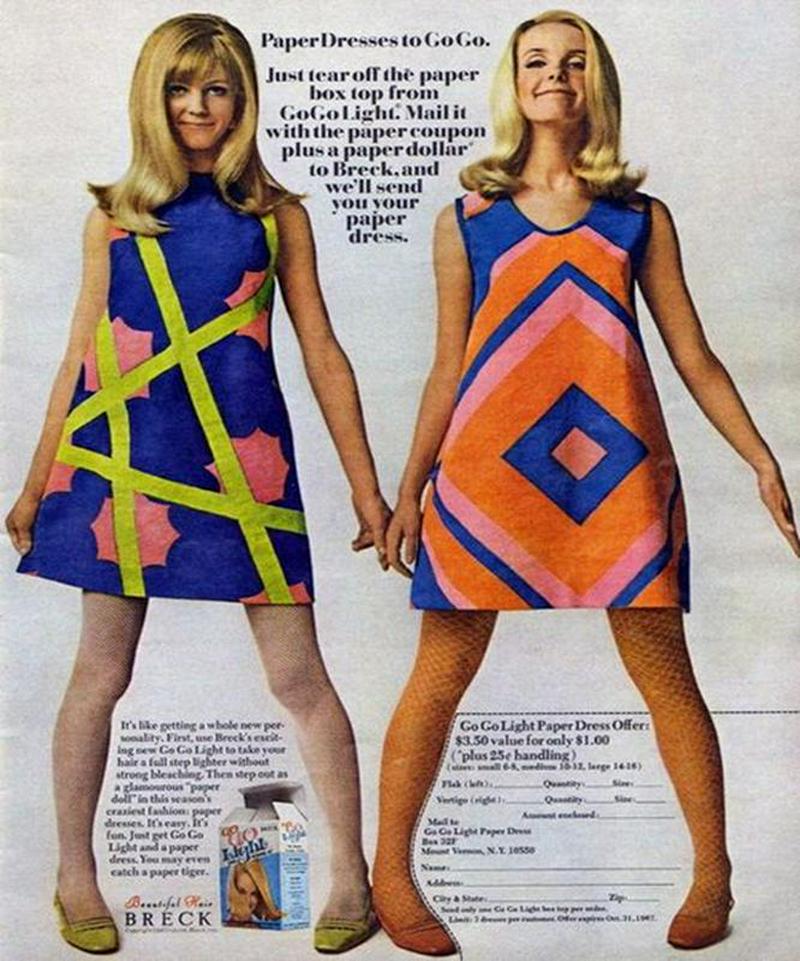Paper Dresses: A Brief 1966 Fashion Fad
By | September 4, 2018

In 1966, the Scott Paper Company introduced the world to paper dresses, a type of disposable fad fashion that became a short-lived viral sensation. The Scott Paper Company was overwhelmed by the craze and rather unprepared for the huge influx of sales. In the first six months of offering paper dresses, the company sold more than half a million paper dresses. Other manufacturers quickly hopped on the bandwagon and, soon, paper garments were everywhere. Sales of disposable paper garments topped $3.5 million at the close of 1966. The novelty craze attracted the attention of wedding and formal wear designers and even pop artist, Andy Warhol.

Paper Dresses? What About Rain? Or Fire?
The paper dresses weren’t as flimsy as we may think they were. They were made of a disposable cellulose material called Dura-Weave, that had been invented and patented in 1958. The fabric was somewhat fire and water resistant. That didn’t mean that the wearer should swim in the outfit or smoke, but it did offer slightly more protection than traditional paper. The fabric was similar to the material used to make those over-sized bibs patients wear at the dentist’s office today.

Paper Dresses Captured The Mod Mood Of The Day
The paper dresses were designed in a simple, shift-dress style with an A-shaped mini skirt. This look was central to the trendy, modern fashions coming out of London and seen on many of icons of the sixties, such as supermodel Twiggy. The youth of the sixties were embracing modernism. They were the first true plastic generation and they grew up with a throw-away mindset. Paper dresses were hip and trendy, but they were also temporary. The wearer could dispose of the dress and move on to newer and better. One marketing slogan for paper dresses even boasted, “Won’t last forever… who cares? Wear it for kicks – then give it the air.”

A Viral Marketing Blitz Helped Make Paper Dresses a Must-Have
The Scott Paper Company thought the dresses would be a novelty item and they printed coupons for the paper garments on the wrappers for their other paper products, like napkins. But when the paper fashion trend picked up momentum, they decided to cash in on the popularity with a full-on marketing blitz. The 1960s was a time when marketing goods and services to the masses was becoming common place. Advertising and consumerism was in its heyday and paper dresses were caught up in the marketing frenzy.

Paper Dresses Became A Marketing, Pop Culture Tool
Pop culture was the phrase of the day in the mid-sixties. This was a time when pop artist Andy Warhol was making waves with his Campbell’s soup art. Commercialism extended into disposable fashion, too. Many of the paper dresses made featured large, over-sized product labels, like Campbell’s soup, candy bars, and soft drinks. It was cool, colorful, and captured the consumerism culture. Budding artist yourself? You could color in your own paper dress to personalize it.

Paper Dresses Expanded into Children’s Wear
As the paper dress fad continued, designers sought ways to expand the offerings to appeal to more and more consumers. One target group was children. The disposable nature of paper clothing was ideal for fast growing children. As one manufacturer’s ad read, it was “Just the thing for the ever-sprouting sprouts.” Most of the children’s offerings were for little girls…simple dresses and pinafores in a wide array of colors and patterns. But little boys could wear paper garments, too. There were paper coveralls designed for young lads.

Formal and Evening Wear Got the Paper Treatment
The affordability of paper dresses made them ideal for one-time formal wear dresses. Fancy evening gowns for sophisticated parties were being offered in the cellulose material. Paper prom dresses was a huge trend in the late 1960s. Brides-to-be could even purchase paper wedding gowns for their big day.

Paper Garments Were For Men, Too
Wear attire made from disposable paper wasn’t just for the ladies. Stylish and trendy men could purchase the novelty, brightly-colored vests, jumpers, bell-bottom pants, tunic shirts, and even full suits. Like the mod-styled paper dresses for young ladies, the clothing items for young men were cool, hip, and modern looking.

Paper Dresses Were a Short-Lived Trend
Even though they were billed as the ‘fabric of the future’ and the ‘new standard material’, the paper dress trend didn’t last long. By the end of the decade, paper garments had run their course. Fashion styles were changing and moving away from the mod mini dress. Plus the environmental awareness of the 1970s ushered in a new way of viewing disposable, throw-away items, like paper dresses. There’s just one thing to be said about paper dresses…they were fun while they lasted.
